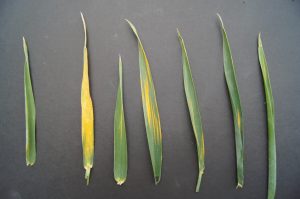Nathan M. Kleczewski Ph.D., Extension Plant Pathologist, University of Delaware
I have had some questions regarding fungicides and application timings in wheat approaching flowering. In particular, the question of efficacy on canopy and head diseases has come up in conversations. The first thing to note is that the fungicides that are recommended for Fusarium Head Blight (FHB) suppression (Caramba, Prosaro, Proline) are effective in controlling foliar diseases. Commonly encountered foliar diseases include Stagonospora leaf blotch, tan spot, powdery mildew, and the rusts. However, it is important to understand that although these products are labeled for FHB, they are only effective if applied at the correct timing. Applying these products before flowering will not result in FHB suppression. This is because the FHB pathogen infects flowering grain heads (Figure 1). Continue reading Late Season Fungicide Applications in Wheat

 s likely damaged much of the wheat crop in Kentucky. The extent and severity of the damage will be better known one to two weeks after the freeze when baseline estimates can be made. Normally, producers would have three options to deal with wheat stands that have been damaged at this stage:
s likely damaged much of the wheat crop in Kentucky. The extent and severity of the damage will be better known one to two weeks after the freeze when baseline estimates can be made. Normally, producers would have three options to deal with wheat stands that have been damaged at this stage: